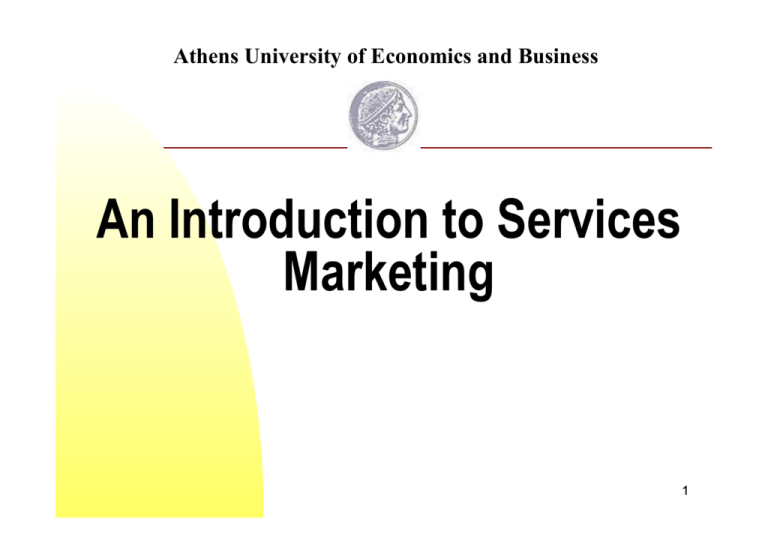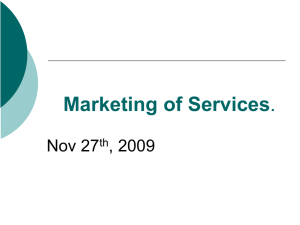An Introduction to Services Marketing
advertisement

Athens University of Economics and Business An Introduction to Services Marketing 1 Defining services “Activities, benefits and satisfactions, which are offered for sale or are provided in connection with the sale of goods” (American Marketing Association, Committee of Definitions 1960, p. 21). “Services include all economic activities whose output is not a physical product or construction, is generally consumed at the time it is produced, and provides added value in forms (such as convenience, amusement, timeliness, comfort or health) that are essentially intangible concerns of its first purchaser” (Quinn, Baruch and Paquette, 1987). 2 Services marketing: from the state of disputed legitimacy to a separate sub-discipline of marketing The life of services marketing has undergone three stages: The Crawling Out stage (Pre-1980) The Scurrying About stage (1980-1985) The Walking Erect stage (1986-today) 3 The Crawling Out Stage (Pre-1980) (I) A period of high risk: If services marketing proved to have a case, the sub-discipline would grow If it was shown that services marketing was a mere extension of goods marketing, the discipline would have no solid base and would disappear The objective: To prove the right of services marketing to exist 4 The Crawling Out Stage (Pre-1980) (II) Views of goods-nurtured marketing academics: “If services marketing becomes a sub-discipline with its own stance, this could challenge the universality of marketing theory and the coherence of marketing as a separate discipline” “Why do we need to pay special attention to the marketing of services, when they are just an aid (an important though) to the production and marketing of goods? (Converse, 1921) Views of service practitioners: “You cannot market a bank account by applying same rules that are used for the marketing of a can of Campbell’s soup” The logic that services are lust like goods resembles the logic that apples are like oranges except for their ‘appleness’” (Shostack, 1977) 5 The Scurrying About Stage (1980-1985) (I) The characteristics: A notable increase in the interest of practitioners and academics in the case of services marketing The debate on the uniqueness of services marketing was partly won The objectives: To reinforce, even further, the argument that, despite similarities, the marketing of services necessitated a different management approach To prove empirically the necessity mentioned above 6 The Scurrying About Stage (1980-1985) (II) The outcome: A significant growth of the empirically based knowledge on the special nature of services Service quality Service encounters (the customer-seller dyadic interaction at the point of sale) Service design New service development 7 The Walking Erect Stage (1986-2003) (I) The characteristics: Very little, is any, further discussion is made on whether or not services require a different marketing management approach: the debate is won The objective: To conduct empirical research in new areas of inquiry in services marketing 8 The Walking Erect Stage (1986-2003) (II) The outcome: The empirical orientation and rigorousness of research on services marketing increase New areas of inquiry are empirically investigated Customer retention Relationship marketing Green issues in services marketing Branding services Internationalisation of services Direct services marketing Sponsorship in services Franchising in services Services marketing is a respected sub-discipline of marketing 9 The Special Characteristics of Services Intangibility Inseparability of production and consumption Heterogeneity Perishability 10 The Intangibility of Services (I) It refers to the total lack or perception of a service’s characteristics before and (often) after it is performed The term was first used in 1963 (Regan) It is the most radical characteristic of services, where from the others emanate Marketing implications Great marketing skills in tangibilising intangible offerings, i.e., in surrounding them with “hard” peripheral attributes Technical superiority and long term vision in new service development, in order to protect a service from its non-patentability Special pricing know-how, i.e., what is the cost of a service? Creative communications skills, i.e., what message to communicate? 11 The Intangibility of Services (II) Criticism to the distinguishing power of intangibility The inability of customers to physically evaluate services is also the case in some goods Repeated use of a service nullifies intangibility Many goods have intangible elements too 12 The Product Tangibility Spectrum Salt Soft drinks Detergents Automobiles Cosmetics Fast-food outlets Tangible dominant products Intangible dominant products Fast-food outlets Advertising agencies Airlines Investment management Shostack, 1977, Journal of Marketing, Vol. 41, April, pp.73-80 Consulting Teaching 13 The Inseparability of Services (I) It refers to the simultaneous production and consumption of services The production process of services has been called “servuction” process (Eiglier and Langeard, 1977) The customer is present when the service is produced The customer plays a role in the servuction and the delivery process Customers interact with one another during the servuction process and may be affected (positively or negatively) by this interaction 14 The Inseparability of Services (II) Marketing implications Mass production of services is difficult, if possible at all No significant economies can be earned from centralization of operations, since the service must be produced at the convenience of customers (temporal and physical) Service quality depends highly on what happens in real time, i.e., during the service encounter Since customers have a vital role in the servuction and delivery process, the service provider needs great skills to train them how to play their role The service provider must prove excellence each time the service is produced The service provider needs skills in order to tackle disruptions in the servuction process, caused by problem customers 15 The Heterogeneity of Services (I) It refers to the potential for high variability in the performance and the quality of services, caused by the interaction between the service employee and the customer The performance of the employees delivering one same service varies: Between different hour zones of the day From employee to employee From service company to service company Not all customers play their role at the service encounter in a homogenous and predictable way Heterogeneity is particularly the case with labour intensive and high-contact services Heterogeneity is less visible in technology-based services 16 The Heterogeneity of Services (II) Marketing implications Need to develop service blueprints (Shostack, 1977), i.e., a production line approach to the servuction process Ability to find a balance between standardisation and personalization during service delivery Ability for real time detection of which side of the encounter causes service failure Need for a mechanism of timely service recovery Skillful selection and motivation of appropriate front-line employees Criticism to the adequacy of heterogeneity as a line of demarcation between goods and services Not all services are heterogeneous, not all goods are homogeneous 17 The Perishability of Services It refers to the fact that services cannot be saved, stored, resold or returned Difficulties in synchronising supply and demand for services Marketing implications Need for developing an as accurate as possible demand forecasting mechanism Need for a creative plan for capacity utilisation Need for the implementation of strategies and actions to accommodate malcontent customers from non-returnable services Criticism to the adequacy of perishability as a line of demarcation between goods and services “Under conditions of fierce competition and financial stringency, the impact on profit of unsold stocks is as severe for manufacturers of fast moving consumer goods as it is for the service industry” (Middleton, 1983) 18 The Expanded Marketing Mix for Services: 3 More Ps (I) People All humans who play a role in service delivery and who influence the perceptions of customers (Zeithaml and Bitner, 1996) Service delivery employees (front-line staff) The general staff of the service company The customer The other customers that are present in the servuction and delivery process Physical Evidence The setting where the service is delivered (Zeithaml and Bitner, 1996) Where the service company and the customer interact Any tangible components that facilitate performance or communication of the service 19 The Expanded Marketing Mix for Services: 3 More Ps (II) Process The actual procedure, mechanisms and flow of activities through which a service is delivered (Zeithaml and Bitner, 1986) The dimensions of a process’s efficiency and effectiveness: Length: the number of steps that participants have to follow in order to effect service delivery Duration: the time that elapses from the first to the last activity of the service delivery process Logistical effectiveness: the degree of smoothness in the flow of the steps of the service delivery process 20 Towards a Strategic Classification of Services Services can be strategically classified according to the following five dimensions (Lovelock, 1983) What is the nature of the service act? What type of relationship does the service organisation have with its customers? How much room is there for customisation and judgment from the service provider? What is the nature of demand and supply for the service? How is the service delivered? 21 The Nature of the Services Act Who or what is the direct recipient of the service? What is the nature of the service act? People Things Tangible actions Services directed at people’s bodies, e.g.: health care Haircutting Beauty salons Services directed at goods physical possessions, e.g.: Freight transportation Laundry and dry cleaning Industrial equipment repair Intangible actions Services delivered at peoples minds, e.g.: Education Theatres Museums Services directed at intangible assets, e.g.,: Banking Accounting Insurance 22 Relationship with the Customer What is the type of the relationship between the service company and the customer? Nature of service delivery Continuous delivery of service Discrete transactions Membership relationship Insurance Telephone subscription Theatre series subscription Football club free season ticket No formal relationship Police protection Radio stations Car rental Mail service Pay phone Public transportation Restaurant 23 Customisation and Judgment in Service Delivery Extent to which the characteristics of a service are customised Extent to which frontline staff have judgment in meeting individual customer needs High High Legal services Health surgery Architectural design for a private residence Private lessons Low Telephone service Hotel services Expensive restaurants Low Large class university education Architectural design for blocks of residence Public transportation Fast-food restaurants 24 Nature of a Service’s Demand relative to Supply Extent of demand fluctuates over time Extent to which supply is constricted Peak demand can be usually met without major delay Peak demand regularly exceeds capacity Wide Electricity Telephone Police and fire emergencies Hotel accommodation Restaurants Narrow Insurance Legal services Banking Service similar to the above, but with incapable capacity 25 Method of Service Delivery Availability of service outlets Nature of interaction between customers and service organisation Customer goes to service organisation Service organisation goes to customer Customer and service organisation transact at arm’s length Single site Theatre Hairdresser’s Multiple sites Bus service Fast-food chain Garden services Taxi Mail delivery services Road assistance services for cars Credit card Local TV station Internet banking Broadcast network National TV station 26 The Service Industry Transportation services Communication services Wholesale and trade Retailing Financial services (banking, insurance, real estate etc.) Tourism services Health services Auto repair services Business services Legal services Government services Education 27 Further Readings Levitt, T., (1981), “Marketing Intangible Products and Product Intangibles”, Harvard Business Review, MayJune, pp. 94-102. Lovelock, C.H., (1983), “Classifying Services to Gain Strategic Marketing Insights”, Journal of Marketing, Vol. 47, Summer, pp. 9-20. Shostack, L.G., (1977), “Breaking Free from Product Marketing”, Journal of Marketing, Vol. 41, April, pp. 7380. Zeithaml, V.A., Parasuraman, A. and Berry, L., (1985), “Problems and Strategies in Services Marketing”, Journal of Marketing, Vol. 49, Spring, pp. 33-46. 28











